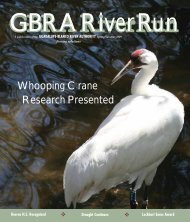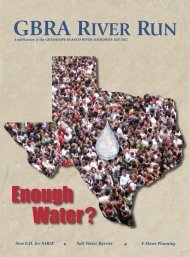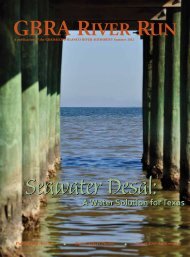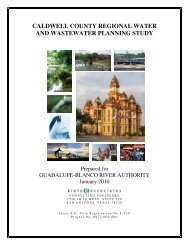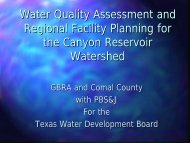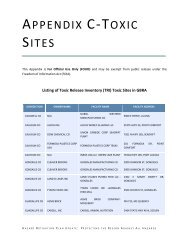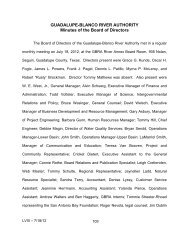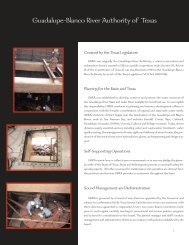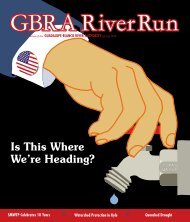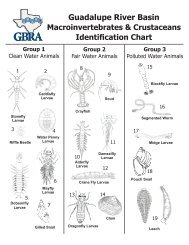Upper San Marcos River Projects by Mary Van Zant, RSI
Upper San Marcos River Projects by Mary Van Zant, RSI
Upper San Marcos River Projects by Mary Van Zant, RSI
- No tags were found...
Create successful ePaper yourself
Turn your PDF publications into a flip-book with our unique Google optimized e-Paper software.
<strong>River</strong> SystemsInstituteUPPER SAN MARCOSRIVER PROJECTSContact us:<strong>River</strong> Systems Institute601 University Drive<strong>San</strong> <strong>Marcos</strong>, TX 78666-4616Phone: 512-245-9200www.rivers.txstate.edurivers@txstate.edu1
THE PROJECTS• <strong>San</strong> <strong>Marcos</strong> ObservingSystem (SMOS)2009 - 2011• Spring Lake WatershedCharacterization andManagementRecommendationsReport2010 - 2012• <strong>Upper</strong> <strong>San</strong> <strong>Marcos</strong>Watershed ProtectionPlan2012 - 20152
SMOSintegratesphysical,hydrologic &geochemical,and biologicalresearchTHE SANMARCOSOBSERVINGSYSTEM (SMOS)Investigateaquaticresourceresponses• variation inflow regimes• anthropogenicimpacts• andinteractionsbetweennative andintroducedflora/fauna3
PHYSICAL•Aquatic Vegetation•Canopy and Shade•<strong>River</strong> Channel Topography•<strong>River</strong>bed Subsurface4
HYDROLOGIC & GEOCHEMICAL•Sediment and dissolvednutrient loads from stormevents• To determine how differentsprings respond in Spring Lake• Monitoring and groundwatercollection samples are taken fromwells in the Sink Creek drainage• Continuous and event data iscollected from Sessom Creek5
BIOLOGICAL•Determine spatial andtemporal trends in occurrenceand abundance ofmacrophytes,macroinvertebrates, andfishes within the upper <strong>San</strong><strong>Marcos</strong> <strong>River</strong>•Assess spatial and temporaltrends in habitat associationsof the upper <strong>San</strong> <strong>Marcos</strong>aquatic community6
SPRING LAKEWATERSHEDCHARACTERIZATION ANDRECOMMENDATIONSREPORTObtain datain order totargetnutrientinputs toSpring LakeDeterminetheinfluence ofvarioussources ofwater onthe algaeandturbidity ofSpring Lake7
COMPONENTS•This project combines data collectionand a stakeholder process to result in aWatershed Characterization•Phase I is an Existing Data Inventory•Phase II is a Data Analysis of new DataCollected in the Project•Phase III is an Estimation of LoadReductions8
WATERSHED CHARACTERIZATION –PHASE 1: DATA INVENTORYMean monthly precipitation at theCity of <strong>San</strong> <strong>Marcos</strong> (1946 – 2011).•A Watershed Inventory•GeographicRepresentation•Evaluation of Sink CreekWatershed Land UsePatterns•Evaluation of NPSgroundwater sourceregions9
WATER QUALITY DATA COLLECTIONAND MONITORING – PHASE II• Continuous Monitoring Program Site Locations and Installation utilizing In-SituTROLL 9500 Professional-XP customizable probes to collect the following data:• Dissolved oxygen (mg/L)• Specific conductance (µS/cm)• Temperature ( o C)• pH/oxidation-reduction potential (E h )• Depth (m)• Turbidity – self cleaning (NTU).• Storm Flow Monitoring Program at 4 locations in Sink Creek• Total phosphorus (TP) concentration• Total nitrogen (TN) concentration• Nitrate-N• Ammonium-N concentration• Orthophosphorus (Ortho-P) concentration• Total suspended solids (TSS) and/or non-volatile suspended solids (NVSS)• Turbidity• Escherichia coli (E. coli).• Periodic Monitoring Program via Grab samples• TP concentration• TN concentration• Nitrate-N concentration• Ammonium-N concentration• Ortho-P concentration• TSS and/or NVSS• Turbidity• E. Coli10
WATERSHED CHARACTERIZATION – PHASE III:IDENTIFICATION OF CAUSES AND SOURCES OFPOLLUTION AND ESTIMATION OF POLLUTANT LOADSREPORT• Watershed Goals and Targets/ManagementObjectives• Identify Causes and Sources of Pollution• Identify Existing Management Efforts• Estimate Pollutant Loads• Identify Potential Critical Areas and GeneralManagement Measures Which Could Lead to LoadReductions• Geographic Representation11
UPPER SAN MARCOSWATERSHEDPROTECTION PLANThis waterbody isimpaired forelevatedTDS, and aWPP willexploremanagementimpacts tosurface andgroundwaterresources.12
COMPONENTS• A Stakeholder Process• Utilize Data from Past <strong>Projects</strong>: SMOS & Spring Lake• Modeling and New Data Collection to identify Causes andsources of pollution• Estimating expected pollution reduction levels• Identifying critical areas of the watershed• Describing management measures needed• Estimating the costs of technical assistance and sources offunding• Outlining an education outreach component• Developing a feasible implementation schedule• Establishing milestones to assess the effectiveness of planimplementation• Developing criteria for assessing success• And establishing a long-term monitoring effort13
•SMOS:http://www.smos-rsi.org/•Spring Lake WatershedCharacterization (underconstruction):http://www.rivers.txstate.edu/research/rivers/san-marcos-riverprojects/spring-lake-watershedcharacterization.html•And USMWPP (underconstruction)http://www.rivers.txstate.edu/research/rivers.html#san_marcos_riverPROJECTWEBSITES14
Thank YouPresented <strong>by</strong>: <strong>Mary</strong> <strong>Van</strong> <strong>Zant</strong>waters@txstate.edu512-245-7551www.rivers.txstate.edu15




